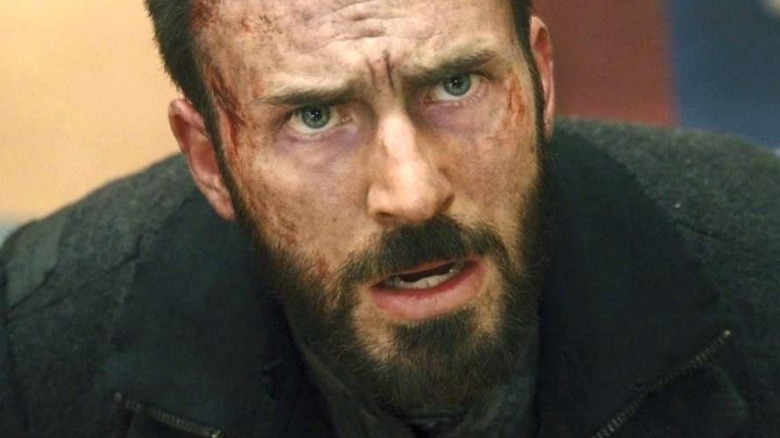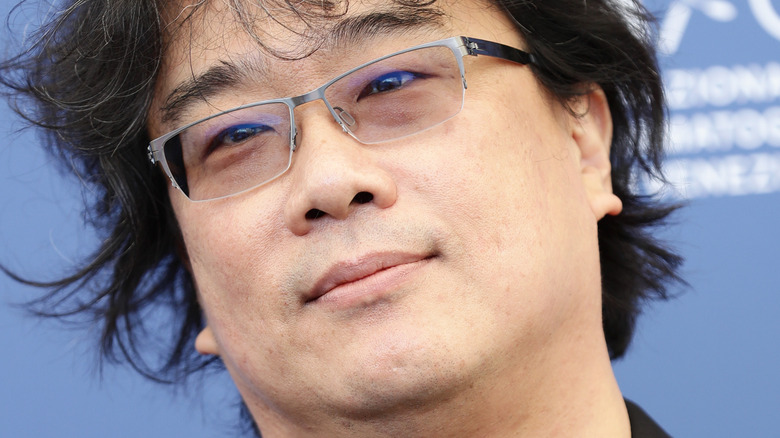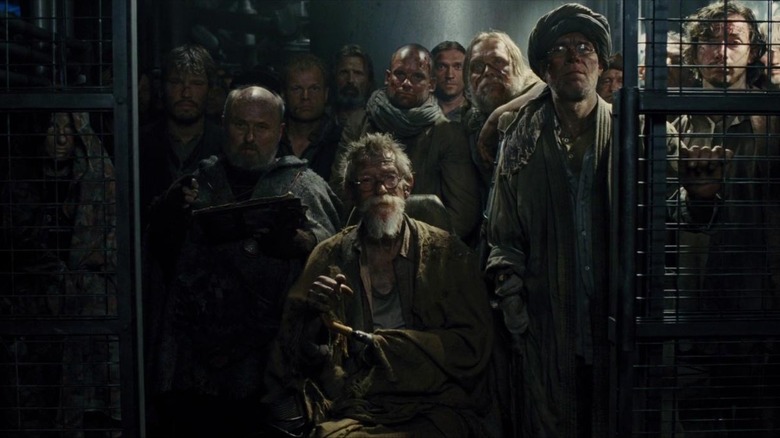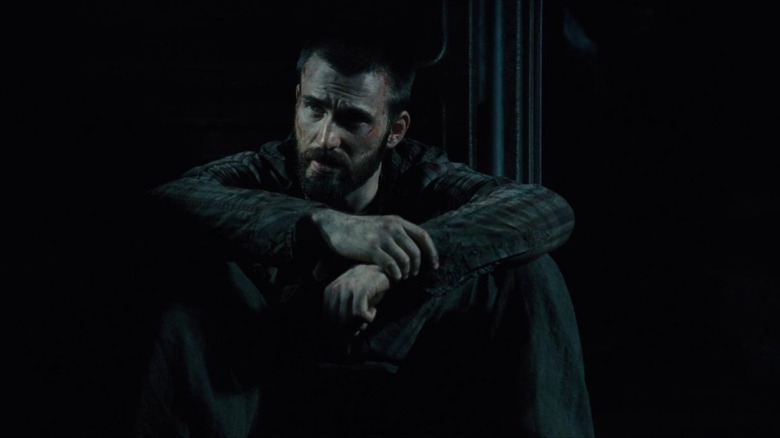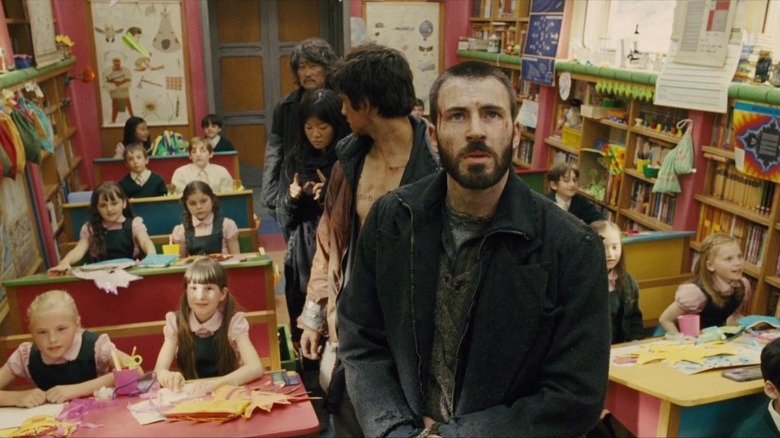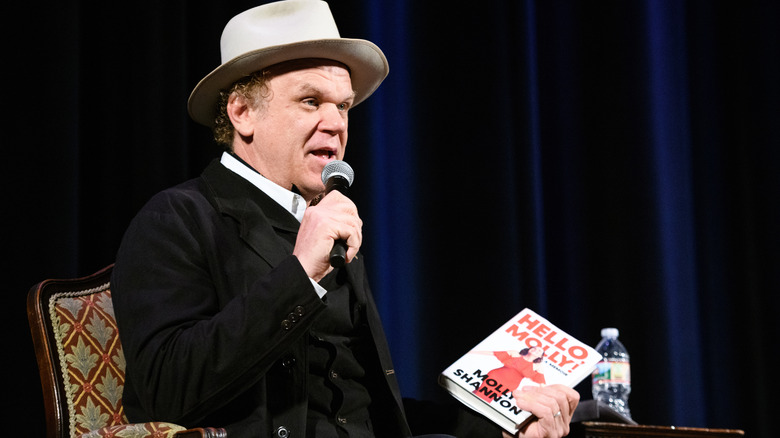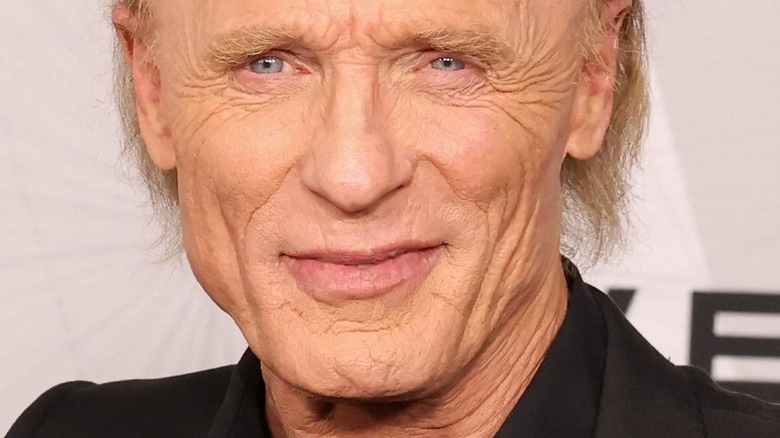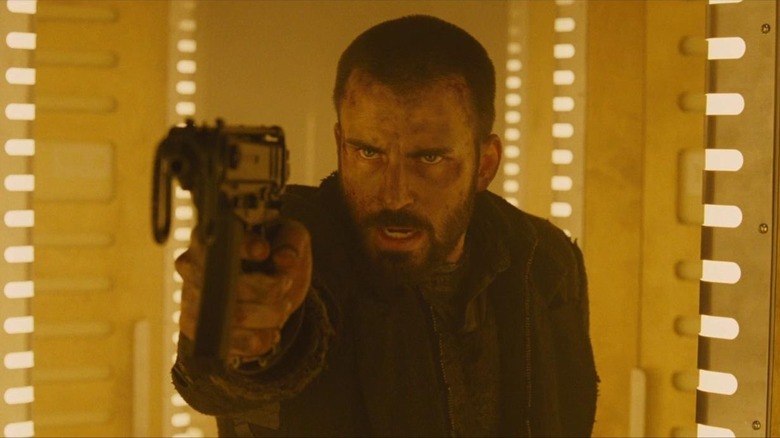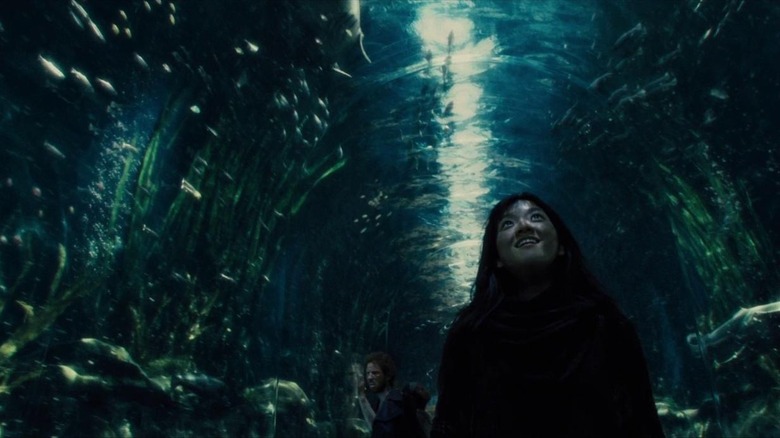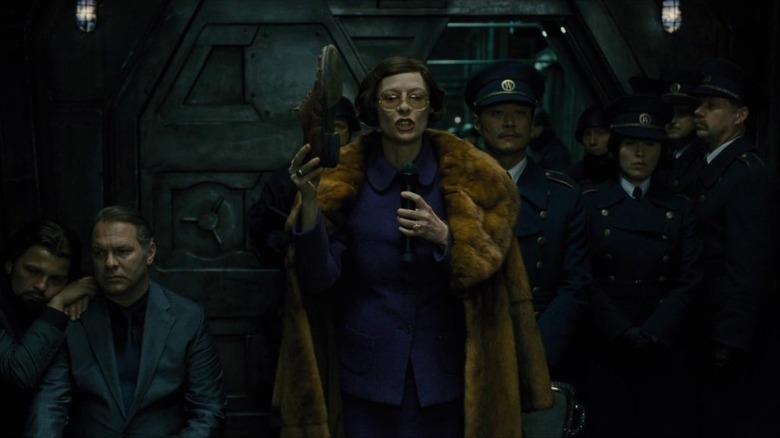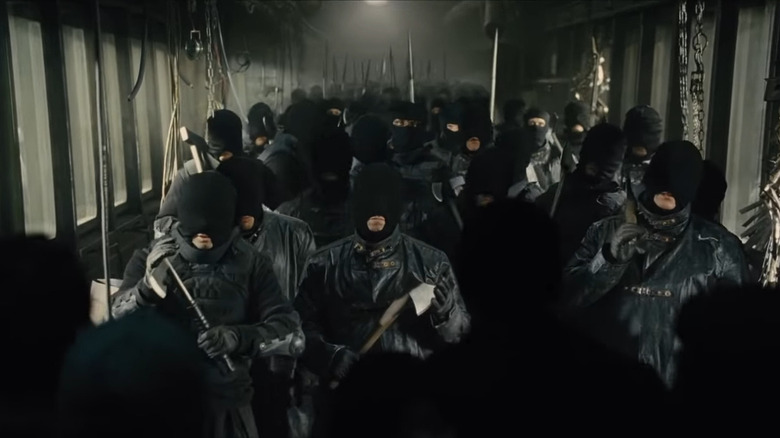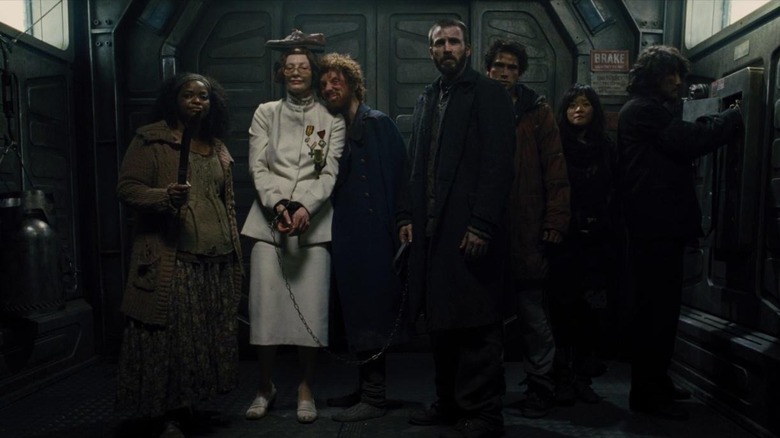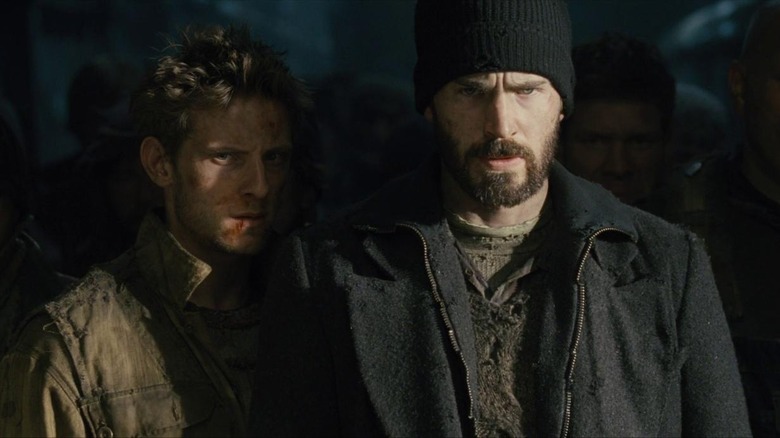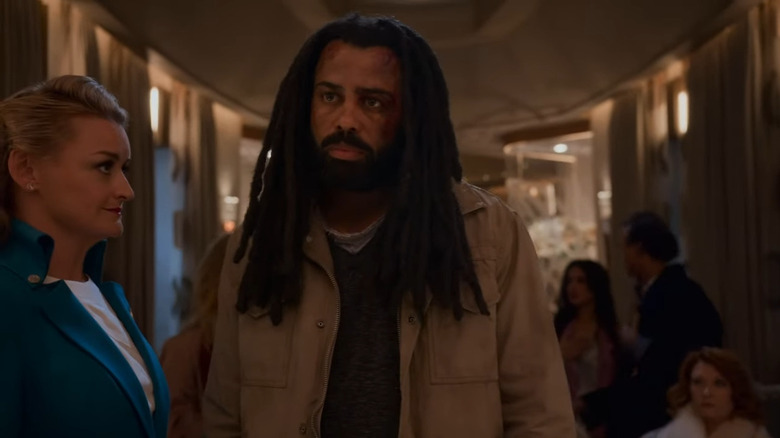The Untold Truth Of Snowpiercer
"Snowpiercer" is the kind of movie that won't leave your brain once it's finished. Like all of director Bong Joon-ho's movies, "Snowpiercer" is plenty entertaining to watch while it's unfolding, but it's packed with layers and details that only become apparent once you stew on the feature for a while. It's the kind of richly rewarding motion picture that requires repeat viewings and captures your imagination. Despite this movie occupying such a bleak wintery post-apocalyptic landscape, the world of "Snowpiercer" is immersive enough to make you wish the movie wouldn't end. Given these artistic feats, it's no surprise that the feature has become a cult favorite, especially given Joon-ho's increased profile in the wake of his historic Oscar victories for "Parasite."
However, the heavily detailed nature of "Snowpiercer" means that there are plenty of behind-the-scenes details and little-known facts under the surface of this movie. This includes what got Bong Joon-ho interested in making "Snowpiercer" in the first place, all the thought that went into the film's unforgettable costume designs, and the lengthy post-production battles the filmmaker experienced trying to preserve his creative vision. It's time to put on your heaviest coat and explore all the details contained within the untold truth of "Snowpiercer."
What drew Bong Joon-ho to Snowpiercer
Though it's become widely associated with its director, "Snowpiercer" isn't the brainchild of Bong Joon-ho. Instead, it's based on a graphic novel entitled "Le Transperceneige" created by Jacques Lob and Jean-Marc Rochette. Talking to IndieWire, Bong noted that what immediately stood out about this material was the claustrophobia of being trapped on a train. Bong has had a lifelong affinity for going into small, tight spaces, like closets. That fascination meant the central backdrop of "La Transperceneige" immediately appealed to him, especially since the inhabitants of the train were trapped inside due to the frozen world outside.
Plus, the train being split into different social classes also appealed to the director. Speaking to Collider, he noted how the structure of the train meant that the audience could experience all these new and bizarre locations at the same as the protagonist, which sounded like a fascinating proposition. Plus, the visual opportunities ingrained into this story, namely in providing such sharp contrasts between grey interiors and blankets of white snow outside, captivated Bong. The combination of rich themes with a visually compelling setting got the director's imagination fired up, and he quickly set out to make "Snowpiercer." While Bong went his own route for the visuals rather than leaning on the imagery of the source material, the basic story elements of "Le Transperceneige" still played a large role in capturing his attention in the first place.
Bong Joon-ho's search for the perfect place to shoot
Initially, it looked like Bong Joon-ho would be shooting "Snowpiercer" in the cold reaches of Canada. Back in 2010, he noted that Canada being such a chilly locale made it a prime target to shoot a movie set in a wintery wasteland while also expressing how impressed he was with Canada's film industry. Though he had lots of glowing words to offer this North American territory, Bong would end up going elsewhere to shoot "Snowpiercer." While searching for the optimal space to film the movie, he did consider his home country of South Korea.
However, there was a snag in these plans. "Snowpiercer's" gigantic sets would require an equally immense soundstage, and no such location existed in South Korea. This was yet another setback for the filmmaker in his quest to figure out where to film "Snowpiercer," though his troubles would soon come to an end once he got to Europe. Here, he found the perfect soundstage in the Czech Republic's capital city, Prague. Save for a day of filming in Austria, the entirety of "Snowpiercer's" principal photography was conducted in the Czech Republic. With this discovery, Bong Joon-ho could finally rest easy, knowing that, after a lengthy search, "Snowpiercer" had found the perfect shooting location.
The excluded romantic subplot
There's a lot crammed into the runtime of "Snowpiercer," which is part of its charm. This is a movie that throws anything and everything at the viewer — you never know what kind of madness the lead characters are going to find next. Though it may seem like the kind of film that left nothing on the table, there's no way that's actually the case. Every motion picture ends up leaving behind plotlines during the development process, and "Snowpiercer" was no different. One especially notable narrative thread that was left behind as the project evolved was a romantic subplot.
Talking to ScreenCraft, screenwriter Kelly Masterson noted that one concept that was toyed with at one point was the idea of giving Curtis some kind of romantic interest. Specifically, the idea was that his love interest would be kidnapped and taken to the front of the train, which would motivate Curtis to keep going. However, this notion got removed early on as he and fellow screenwriter Bong Joon-ho began to nail down the character. The deletion of this concept is a good symbol of how maximalist movies don't have to indulge in every creative impulse. For the sake of having cohesive characters, even an ambitious movie like "Snowpiercer" can't do everything.
Snowpiercer took a while to make
Much like Rome, feature films aren't made in a day — they're created gradually over time. That's just as true for "Snowpiercer" as anything else, which took four years to make. Talking to Collider, Bong Joon-ho noted that the lengthy production schedule for "Snowpiercer" included an enormous pre-production period. Getting the dense world of the film just right required a lot of energy and hours from Bong, but it wasn't the only aspect of the film that kept him busy before the cameras started rolling. He also noted that he took more time than usual on the script, partially so he could hash out the English-language dialogue with "Snowpiercer's" other screenwriter, Kelly Masterson.
Bong also had to spend a considerable amount of time getting all the editing and shot choices planned out well in advance for "Snowpiercer" because of the film's smaller budget limiting how much they could and couldn't shoot. On top of everything else, Bong's time commitments to "Snowpiercer" also ended up including lengthy post-production fights with Harvey Weinstein, who was tasked with distributing the movie in key countries like the United States and the United Kingdom. "Snowpiercer" took years and years of Bong Joon-ho's life to create, with all that effort at least being readily apparent on the screen.
John C. Reilly was eyeballed for the Minister Mason role
It's hard to imagine anyone but Tilda Swinton taking on the role of Minister Mason in "Snowpiercer." A performer who makes the phrase "be a shoe" carry all the immense menace in the world and then some, Swinton wholly commits to the part. In the process, she creates someone who can be occasionally amusingly eccentric but whose never not terrifying. However, Swinton wasn't always the primary person up for this role. Long before production began, Bong Joon-ho had a radically different actor in mind for this part.
Talking to Cinapse, the director noted that he and Swinton had first talked about "Snowpiercer" years before the movie came out, when they were both at the Cannes Film Festival. In this conversation, the duo expressed a mutual desire to work with one another, but there was an issue. At the time, there wasn't a part for Swinton in the script since Minister Mason was originally written as a man. At this stage of the production, John C. Reilly was being eyeballed for the role. Considering Reilly's gift for balancing comedy and drama in his performances, it's easy to imagine that he could've also made a good Mason. However, there's no denying that Swinton and Minister Mason were meant to be, and thanks to Bong giving the "Snowpiercer" script a rewrite, this exciting merger of character and actor was made possible.
Why Ed Harris pursued Snowpiercer
"Snowpiercer" was the first Bong Joon-Ho directorial effort to prominently incorporate English-speaking actors. This meant that an opportunity opened up for a whole slew of actors to appear in the feature who couldn't have appeared in earlier Bong titles like "Memories of Murder" or "Mother." Among those assembled for the production was Ed Harris, who wound up playing the man in control of the titular train. An esteemed actor with an enormously impressive list of acting credits, Harris openly pursued the chance to work with Bong.
"I saw three of director Bong's movies, and I said, 'I want to do this. I don't care what he's asking me to do because he's a really great filmmaker,'" Harris recalled to Collider. After that, Harris was put into the cast as the villainous Wilford. However, all of his prior experiences watching Bong Joon-ho movies couldn't have prepared Harris for what it was like to step onto the set of "Snowpiercer." The scale and detail of the movies sets, not to mention Bong's directorial approach of constantly alternating his filmmaking style, left him thoroughly impressed.
Chris Evans' initial response to the script
Chris Evans may be most well-known for starring as Captain America in the Marvel Cinematic Universe, but he's also shown a tendency to work with auteurs throughout his career. Evans has collaborated with filmmakers ranging from Danny Boyle to Rian Johnson to Edgar Wright, among others. With "Snowpiercer," Evans got to make a movie with Bong Joon-ho, one of the most celebrated filmmakers of the modern era. However, it wasn't just the allure of getting to act under the direction of the man responsible for "Mother" and "The Host" that got Evans excited about headlining "Snowpiercer."
Talking to Collider, Evans recalled how, when he first read the script for "Snowpiercer," there were plenty of moments that left him baffled and wondering what this movie was even going to look like. But while talking to Bong Joon-ho about these queries, Evans was told that the specifics of the lore were irrelevant. What was important was the larger picture that "Snowpiercer" was working towards, the greater themes that its story could symbolize. For Evans, being a part of a movie that evoked "Blade Runner" in how it trusts audience to explore something new without exposition was enough to get him to join the wild ride that is "Snowpiercer."
How much of Snowpiercer was shot on a set?
Some films benefit greatly from being shot out in the real world away from enormous soundstages, like "Apocalypse Now." But for other titles, there's no way they can capture their fictitious worlds in real-life environments. For instance, "Snowpiercer" takes place in a futuristic train riding around in a snowy apocalyptic landscape. It would've been a nightmare to find and then film in real-world backdrops that could approximate these settings. Thus, Bong Joon-ho turned heavily towards meticulously detailed sets to bring his grand vision for this movie to life.
According to Den of Geek, a massive replica of the movie's train, spanning 100-meters, was built. Not only did this convey the scale of the train, but it could even convey movement that evoked the kind of jostling the passengers aboard Snowpiercer would face every day. This was housed on a gargantuan soundstage located in the Czech Republic. While this meant that the cast and crew of "Snowpiercer" weren't actively fighting against the harsh elements of winter while shooting the movie, they still had an expansive and richly detailed set to work with rather than just a barrage of green-screen backdrops. Sometimes, shooting on a set, especially one overseen by Bong Joon-ho, can be just as rewarding as shooting on location.
The thought process behind the costumes
Costume designer Catherine George relished all the unique challenges that came with designing the outfits for the characters of "Snowpiercer." Talking to Hello Tailor, George noted that her work on the movie began and ended with considerations for how the economic status of the individual passengers would affect their costumes. Those in the tail section, for instance, would have fragmented clothes that showed their wear and tear. Different cultures from around the world inspired different characters in the film, with attire of people from Africa and India, for example, informing the wardrobe of assorted "Snowpiercer" characters.
George also recalled how "Snowpiercer" was designed to be a more grounded take on sci-fi narratives, so she stayed away from heightened, over-the-top costumes seen in other science fiction movies. However, that doesn't mean the costumes were devoid of influence from classic sci-fi tales, with Andrei Tarkovsky's "Stalker" being an especially big inspiration in terms of how to balance vastly different color schemes in one movie. All of this attention to detail on the part of George proved critical in making the world of "Snowpiercer" feel all the more alive, as well as finding unique ways for the personalities of individual characters to be reinforced.
Bong Joon-ho vs. Harvey Weinstein
While filming "Snowpiercer" was full of fulfilling moments, there was trouble awaiting everyone involved in the movie's post-production phase. This is where producer Harvey Weinstein, who handled the film's distribution in a handful of territories, began demanding lengthy cuts to the film. Bong Joon-ho recalled to Vulture how, up to this point in his career, he hadn't had to deal with such immense studio interference. Even if he had met this kind of meddling before, though, there's no doubt that he would've been mortified by Weinstein's behavior, which included a demand that the filmmaker cut out a scene where one of the villains gut a fish in an act of intimidation towards the heroes.
Bong, determined to keep this gutting in the final cut, told Weinstein that there was an underlying point to this moment. The director explained that his father was a fisherman and that this sequence was meant as a tribute to his dad. Weinstein then emphasized that family is important above all else and decided to relent. The fish would remain in the movie. When recalling this interaction years later, though, Bong punctuated the anecdote by revealing that his story to Weinstein was a lie — his father was not a fisherman. It was just the only way Bong was able to cut through Weinstein's overly controlling hands.
Snowpiercer's U.S. release struggles
Though "Snowpiercer" was a critically acclaimed genre movie released in the heart of summertime with Chris Evans in the lead role (fresh off headlining "Captain America: The Winter Soldier, to boot), "Snowpiercer" never got a wide theatrical release in North America. This is entirely due to the producer tasked with shepherding its domestic debut, Harvey Weinstein. His studio, The Weinstein Company, secured distribution rights to "Snowpiercer" in North America and a handful of other countries in late 2012. Originally committing to a big theatrical release, plans began to change as tensions between Bong Joon-ho and Weinstein escalated.
By late 2013, Bong revealed that he was having struggles with Weinstein, who wanted to cut down "Snowpiercer" significantly for its debut in many English-language countries. The filmmaker would later expand on these issues by noting that Weinstein wanted to add expository voiceovers to the beginning and end of "Snowpiercer," in addition to trimming down its runtime. Eventually, mounting pressure led to Bong Joon-ho's original vision of "Snowpiercer" getting released in North American movie theaters, albeit in a parred-down release from Weinstein's RADiUS-TWC division. Many still were left somberly wondering what "Snowpiercer" could've accomplished if it had been given its initial wide theatrical release. But at least the filmmaker's vision managed to triumph against studio executive meddling.
The box office run of Snowpiercer
If you were to look at just the international numbers for "Snowpiercer," it was unquestionably a solid hit. Grossing $82.2 million overseas, "Snowpiercer" managed to double its $40 million budget through the international box office alone. Meanwhile, it became Bong Joon-ho's second-biggest movie ever globally at the time of its release, coming in only slightly behind the $92.6 million total of his 2007 feature "The Host." Unfortunately, "Snowpiercer's" domestic total was much lower than its foreign box office, though this wasn't due to "Snowpiercer" failing to connect with moviegoers in this region.
Instead, the film's North American box office performance was kneecapped by the decision to give it a simultaneous premium video-on-demand and theatrical release, which immediately limited how many theaters it could play in. Under those circumstances, "Snowpiercer" didn't do terrible business as it grossed $4.5 million theatrically in this territory despite never playing in more than 356 locations and being available in people's homes. Among 2014 titles, it managed to outgross the likes of "Before I Go to Sleep," "Wish I Was Here," and "The Identical" despite all those movies playing in hundreds of additional theaters. Though it wasn't able to fulfill its fullest box office potential in this market, "Snowpiercer" still did fine under its strange release circumstances in North America and certainly made more than enough in international territories.
Translating Snowpiercer to television
Though "Snowpiercer" struggled to get a theatrical release in many countries, it proved to be a highly viable commodity once it entered the global consciousness. There was no better indication of this than the announcement of an English-language "Snowpiercer" TV show in November 2015. The program would eventually premiere in May 2020 and would prove successful enough with viewers to last four seasons. (Reviews from critics tended to be mixed, a sharp contrast to the general acclaim that greeted the "Snowpiercer" movie in its global theatrical run.)
In bringing this program to life, showrunner Graeme Manson was determined to make sure "Snowpiercer" wasn't just a retread of the movie that spawned it. As a result, the show ended up focusing on a variety of different classes that occupied the titular train while using the episodic nature of television to dive into each of the classes in an in-depth fashion. Initially focusing on a murder mystery was another way the "Snowpiercer" TV show wanted to separate its narrative from its feature-length counterpart. While some aspects of the original motion picture (such as those protein-packed bug bars) were maintained, the "Snowpiercer" TV show made great strides conceptually to make sure it could offer something unique to viewers.
